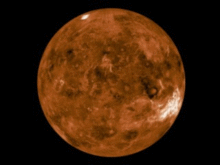
Back جيولوجيا الزهرة Arabic Geologia de Venus Catalan Povrch Venuše Czech Geología de Venus Spanish Artizarreko geologia Basque Venuksen geologia Finnish Géologie de Vénus French शुक्र का भूविज्ञान Hindi Վեներայի երկրաբանություն Armenian Geologi Venus ID
This article needs additional citations for verification. (February 2020) |


The geology of Venus is the scientific study of the surface, crust, and interior of the planet Venus. Within the Solar System, it is the one nearest to Earth and most like it in terms of mass, but has no magnetic field or recognizable plate tectonic system. Much of the ground surface is exposed volcanic bedrock, some with thin and patchy layers of soil covering, in marked contrast with Earth, the Moon, and Mars. Some impact craters are present, but Venus is similar to Earth in that there are fewer craters than on the other rocky planets that are largely covered by them. This is due in part to the thickness of the Venusian atmosphere disrupting small impactors before they strike the ground, but the paucity of large craters may be due to volcanic re-surfacing, possibly of a catastrophic nature. Volcanism appears to be the dominant agent of geological change on Venus. Some of the volcanic landforms appear to be unique to the planet. There are shield and composite[citation needed] volcanoes similar to those found on Earth, although these volcanoes are significantly shorter than those found on Earth or Mars.[1] Given that Venus has approximately the same size, density, and composition as Earth, it is plausible that volcanism may be continuing on the planet today, as demonstrated by recent studies.[2]
Most of the Venusian surface is relatively flat; it is divided into three topographic units: lowlands, highlands, and plains. In the early days of radar observation the highlands drew comparisons to the continents of Earth, but modern research has shown that this is superficial and the absence of plate tectonics makes this comparison misleading. Tectonic features are present to a limited extent, including linear "deformation belts" composed of folds and faults. These may be caused by mantle convection. Many of the tectonic features such as tesserae (large regions of highly deformed terrain, folded and fractured in two or three dimensions), and arachnoids (those features resembling a spider's web) are associated with volcanism.
Eolian landforms are not widespread on the planet's surface, but there is considerable evidence the planet's atmosphere causes the chemical weathering of rock, especially at high elevations. The planet is remarkably dry, with only a chemical trace of water vapor (20 ppm) in the Venusian atmosphere. No landforms indicative of past water or ice are visible in radar images of the surface. The atmosphere shows isotopic evidence of having been stripped of volatile elements by off-gassing and solar wind erosion over time, implying the possibility that Venus may have had liquid water at some point in the distant past; no direct evidence for this has been found. Much speculation about the geological history of Venus continues today.
The surface of Venus is not easily accessible because of the extremely thick atmosphere (some 90 times that of Earth's) and the 470 °C (878 °F) surface temperature. Much of what is known about it stems from orbital radar observations, because the surface is permanently obscured in visible wavelengths by cloud cover. In addition, a number of landers have returned data from the surface, including images.
Studies reported in October 2023 suggest for the first time that Venus may have had plate tectonics during ancient times and, as a result, may have had a more habitable environment, possibly once capable of harboring life forms.[3][4]
- ^ Keddie, S. T.; Head, J. W. (1994-06-01). "Height and altitude distribution of large volcanoes on Venus". Planetary and Space Science. 42 (6): 455–462. doi:10.1016/0032-0633(94)90088-4. ISSN 0032-0633.
- ^ Justin Filiberto; et al. (3 January 2020). "Present-day volcanism on Venus as evidenced from weathering rates of olivine". Science Advances. 6 (1): eaax7445. Bibcode:2020SciA....6.7445F. doi:10.1126/sciadv.aax7445. PMC 6941908. PMID 31922004.
- ^ Cite error: The named reference
NYT-20231026was invoked but never defined (see the help page). - ^ Cite error: The named reference
NA-20231026was invoked but never defined (see the help page).